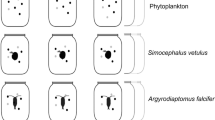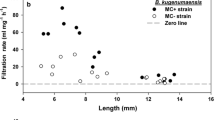Abstract
The biocontrol effects of Caridina denticulata, an atyid shrimp, on toxic cyanobacterial bloom (Microcystis aeruginosa) were evaluated in a mesocosm study with stable isotope tracers (13C and 15N) in a eutrophic agricultural reservoir. The accumulated assimilation (at.%) of M. aeruginosa into C. denticulata was increased, causing a significant reduction in the concentration of Chlorophyll-a. The ingestion rate of M. aeruginosa by C. denticulata was influenced by predation pressure exerted by bagrid catfish Pseudobagrus fulvidraco and was dependent on biomass ratio. C. denticulata affected zooplankton density, species composition, and ingestion rate, demonstrating that the number of small-sized cladocerans (Bosmina coregoni and Bosmina longispina) increased because they grazed M. aeruginosa for a food source. This study suggests that C. denticulata and P. fulvidraco can be feasible material to control a nuisance M. aeruginosa bloom in eutrophic agricultural reservoir.








Similar content being viewed by others
References
Abrams PA, Walters CM (1996) Invulnerable prey and the paradox of enrichment. Ecology 77:1125–1133
An KG, Lee JY, Kumar HK, Lee SJ, Hwang SJ, Kim BH, Park SK, Um HY (2010) Control of algal scum using top-down biomanipulation approach and ecosystem health assessments for efficient reservoir management. Water Air Soil Pollut 205:3–24
APHA (2005) Standard methods for the examination of water and wastewater. American Public Health Association, New York
Arditi R, Ginzburg LR (1991) Variation in plankton densities among lakes: a case for ratio-dependent predation models. Am Nat 138:1287–1296
Arditi R, Perrin N, Saiah H (1991) Functional responses and heterogeneities: an experimental test with cladocerans. Oikos 60:69–75
Beattie KA, Ressler J, Wiegand C, Krause E, Codd GA (2003) Comparative effects and metabolism of two microcystins and nodularin in the brine shrimp Artemia salina. Aquat Toxicol 62(3):925–935
Benndorf J (1990) Conditions for effective biomanipulation: conclusions derived from whole-lake experiments in Europe. Hydrobiologia 200(201):187–203
Bernardi RD, Giussani G (1990) Are blue-green algae a suitable food for zooplankton? An overview. Hydrobiologia 200(201):29–41
Bontes BM, Verschoo AM, Dionisio Pires LM, Van Donk E, Ibelings BW (2007) Functional response of Anodonta anatina feeding on a green algal and four strains of cyanobacteria, differing in shape, size and toxicity. Hydrobiologia 584:191–204
Bunn SE, Boon PI (1993) What sources of carbon drive food webs in billabongs? A study based on stable isotope analysis. Oecologia 96:85–94
Burns A, Walker KF (2000) Biofilms as food for decapods (Atyidae, Palaemonidae) in the River Murray, South Australia. Hydrobiologia 437:83–93
Burns CW, Forsyth DJ, Haney JF, James MR, Lampert W, Pridmore RD (1989) Coexistence and exclusion of zooplankton by Anabaena minutissima var. attenuate in Lake Rotongaio, New Zealand. Arch fur Hydrobiol 32:63–82
Degans H, De Meestser L (2002) Top-down control of natural phyto- and bacterioplankton prey communities by Daphnia magna and by the natural zooplankton community of the hypertrophic Lake Blankaart. Hydrobiologia 439:39–49
DeMott WR, Moxter F (1991) Foraging on cyanobacteria by copepods: responses to chemical defenses and resource abundance. Ecology 72:1820–1834
Dittmann E, Wiegand C (2006) Cyanobacterial toxins—occurrence, biosynthesis and impact on human affairs. Mol Nutr Food Res 50:7–17
Dodson SI (1974) Zooplankton competition and predation: an experimental test of the size-efficiency hypothesis. Ecology 55:605–613
Engstrom J, Viherluoto M, Viitasalo M (2001) Effects of toxic and non-toxic cyanobacteria on grazing, zooplanktivory and survival of the mysid shrimp Mysis mixta. J Exp Mar Biol Ecol 257:269–280
Engstrom J, Lehtiniemi M, Green K, Kozlowsky-Suzuki B, Viitasalo M (2002) Does cyanobacterial toxin accumulate in mysid shrimps and fish via copepods? J Exp Mar Biol Ecol 276:95–107
Fulton RS, Paerl HW (1987) Toxic and inhibitory effects of the blue-green alga Microcystis aeruginosa on herbivorous zooplankton. J Plankton Res 9:837–855
Gemmell P (1978) Feeding habits and structure of the gut of the Australian freshwater prawn Paratya australiensis Kemp (Crustacea, Caridea, Atyidae). Proc Linn Soc N S W 103:209–216
Ghadouani A, Pinel-Alloul BB, Plath K, Codd GA, Lampert W (2004) Effects of Microcystis and purified microcystin-LR on the feeding behavior of Daphnia pulicaria. Limnol Oceanogr 49:666–679
Gorokhova E, Hansson S (1997) Effects of experimental conditions on the feeding rate of Mysis mixta (Crustacea, Mysidacea). Hydrobiologia 355:167–172
Hansson S, De Stasio BT, Gorokhova E, Mohammadian MA (2001) Ratio-dependent functional responses—tests with the zooplanktivore Mysis mixta. Mar Ecol Prog Ser 216:181–189
Harada KI, Matsuura K, Suzuki M, Oka H, Watanabe MF, Oishi S, Dahlem AM, Beasley VR, Carmichael WW (1988) Analysis and purification of toxic peptides from cyanobacteria by reversed-phase high-performance liquid chromatography. J Chromatogr 448:275–283
Henning M, Hertel H, Wall H, Kohi JG (1991) Strain-specific influence of Microcystis aeruginosa on food ingestion and assimilation of some cladocerans and copepods. Int Rev Gesamten Hydrobiol 76:37–45
Holling CS (1959) The components of predation as revealed by a study of small-mammal predation of the European pine sawfly. Can Entomol 91:293–320
Hwang S-J, Yoon CG, Kweon SK (2003) Water quality and limnology of Korean reservoirs. Paddy Water Environ 1:43–52
Jarvis AC, Hart RC, Combrink S (1987) Zooplankton feeding on size fractionated Microcystis colonies and Chlorella in a hypereutrophic lake (Hartbeespoort Dam, South Africa): implications to resource utilization and zooplankton succession. J Plankton Res 9:1231–1249
Jeppesen E, Jesen JP, Sondergaard M, Lauridsen T, Pedersen LJ, Jensen L (1997) Top-down control in freshwater lakes: the role of nutrient state, submerged macrophytes and water depth. Hydrobiologia 342(343):151–164
Kim H-S, Hwang S-J (2004) Seasonal variation of water quality in a shallow eutrophic reservoir. Korean J Limnol 37(2):180–192
Kim H-S, Hwang S-J, Shin J-K, An K-G, Yoon CG (2007) Effects of limiting nutrients and N: P ratios on the phytoplankton growth in a shallow hypertrophic reservoir. Hydrobiologia 581:255–267
Kim MS, Lee WS, Kumar KS, Shin KH, Robarge W, Kim MS, Lee SY (2016) Effects of HCl pretreatment, drying, and storage on the stable isotope ratios of soil and sediment samples. Rapid Commun Mass Spectrom 30:1567–1675
Kirk KL, Gilbert JJ (1992) Variation in herbivore response to chemical defenses: zooplankton foraging on toxic cyanobacteria. Ecology 73:2208–2217
Koski M, Rosenberg M, Viitasalo M (1999) Reproduction and survival of the calanoid copepod Eurytemora affinis fed with toxic and non-toxic cyanobacteria. Mar Ecol Prog Ser 186:187–197
Lakshmi S (1975) On the early larval development of Caridina sp. (Crustacea, Decapoda, Atyidae). Indian J Fish 22(1–2):68–79
Lampert W (1981) Toxicity of the blue-green Microcystis aeruginosa: effective defence mechanism against grazing pressure by Daphnia. Proc Int Assoc Theor Appl Limnol 21:1436–1440
Lu M, Xie P, Tang HJ, Shao ZJ, Xie LQ (2002) Experimental study of trophic cascade effect of silver carp (Hypophthalmichthys molitrix) in a subtropical lake, Lake Donghu: on plankton community and underlying mechanisms of changes of crustacean community. Hydrobiologia 487:19–31
Lu K, Jin C, Dong C, Gu B, Bowen SH (2006) Feeding and control of blue-green algal blooms by tilapia (Oreochromis niloticus). Hydrobiologia 568:111–120
Matveev V, Matveeva LA, Jones GJ (1994) Study of the ability of (Daphnia carinata) King to control phytoplankton and resist cyanobacterial toxicity: implications for biomanipulation in Australia. Aust J Mar Freshwat Res 45:889–904
Mehner T, Arlinghaus R, Berg S, Dorner H, Jacobsen L, Kasprzak P, Koschel R, Schulze T, Skov C, Wolter C, Wysujack K (2004) How to link biomanipulation and sustainable fisheries management: a step-by-step guideline for lakes of the European temperate zone. Fish Manag Ecol 11:261–275
Mohamed ZA, Carmichael WW, Hussein AA (2003) Estimation of microcystins in the freshwater fish Oreochromis niloticus in an Egyptian fish farm containing a Microcystis bloom. Environ Toxicol 18:137–141
Pagano M, Saint-Jean L, Arfi R, Bouvy M, Guiral D (1999) Zooplankton food limitation and grazing impact in a eutrophic brackish-water tropical pond (Cote D’Ivoire, West Africa). Hydrobiologia 390:83–98
Parker PL, Anderson RK, Lawrence A (1989) A δ 13C and δ 15N tracer study of nutrition in aquaculture: Penaeus vannamei in and pond grow out system. In: Rundel PW, Ehleringer JR, Nagy KA (eds) Stable Isotopes in Ecological Research. Springer-Verlag, New York, pp 288–303
Pearl HW, Huisman J (2008) Blooms like it hot. Science 320:57–58
Pearl HW, Fulton RS, Moisander PH, Dyble J (2001) Harmful freshwater algal blooms with an emphasis on cyanobacteria. Sci World 1:76–113
Perrow MR, Jowitt AJD, Stansfield JH, Coops H (1997) Biomanipulation in shallow lakes: state of the art. Hydrobiologia 342(343):355–365
Peterson BJ, Fry B (1987) Stable isotopes in ecosystem studies. Annu Rev Ecol Evol Syst 18:293–320
Pflugmacher S, Wiegand C, Oberemm A, Beattie KA, Krause E, Codd GA, Steinberg CEW (1998) Identification of an enzymatically formed glutathione conjugate of the cyanobacterial hepatotoxin microcystin-LR: the first step of detoxication. Biochim Biophys Acta 1425:527–533
Piola RF, Suthers IM, Rissik D (2008) Carbon and nitrogen stable isotope analysis indicates freshwater shrimp Paratya australiensis Kemp, 1917 (Atyidae) assimilate cyanobacterial accumulations. Hydrobiologia 608:121–132
Sarnelle O (1993) Herbivore effects on phytoplankton succession in a eutrophic lake. Ecol Monogr 63:129–149
Sarnelle O (2005) Daphnia as keystone predators: effects on phytoplankton diversity and grazing resistance. J Plankton Res 27:1229–1238
Shapiro J, Wright DI (1984) Lake restoration by biomanipulation. Freshw Biol 14:371–383
Shapiro J, Lamarra V, Lynch M (1975) Biomanipulation: an ecosystem approach to lake restoration. In: Brezonik PL, Fox JL (eds) Proceeding of a Symposium on water quality management through biological control. University of Florida, Gainesville, pp 85–89
Sih A, Crowley P, McPeek M, Petranka J, Strohmeie K (1985) Predation, competition and prey communities: a review of field experiments. Annu Rev Ecol Evol Syst 16:269–311
Starling FL (1993) Control of eutrophication by silver carp (Hypophthalmichthys molitrix) in the tropical Paranoa Reservoir (Brasilia, Brazil): a mesocosm experiment. Hydrobiologia 257:143–152
Strickland JDH, Parsons TR (1968) A Practical Handbook of Seawater Analysis. Bull Fish Res Board Can 169:1–203
Sweeting CJ, Polunin NVC, Jennings S (2004) Tissue and fixative dependent shifts of δ 13C and δ 15N in preserved ecological material. Rapid Commun Mass Spectrom 18:2587–2592
Vasconcelos V, Oliveira S, Teles FO (2001) Impact of a toxic and a non-toxic strain of Microcystis aeruginosa on the crayfish Procambarus clarkii. Toxicon 39:1461–1470
Viherluoto M, Kuosa H, Flinkman J, Viitasalo M (2000) Food utilization of pelagic mysids, Mysis mixta and M. relicta, during their growing season in the northern Baltic Sea. Mar Biol 136:553–559
Wiegand C, Pflugmacher S, Oberemm A, Meems N, Beattie KA, Steinberg CEW, Codd GA (1999) Uptake and effects of microcystin-LR on detoxication enzymes of early life stages of the zebra fish (Danio rerio). Environ Toxicol 14:89–95
Xie P, Yang Y (2000) Long-term changes of Copepoda community (1957–1996) in a subtropical Chinese lake stocked densely with planktivorous filter-feeding silver and bighead carp. J Plankton Res 22(9):1757–1778
Acknowledgements
This study was supported by the project (No. 306009-03-2-CG000) of the Agricultural Technology Development Center, Ministry of Agriculture and Forestry, Korea (Project Title: Development of a strategy for water quality management using biomanipulation (food chain) in agricultural reservoirs. 2006–2009).
Author information
Authors and Affiliations
Corresponding authors
Rights and permissions
About this article
Cite this article
Kim, MS., Lee, Y., Hong, S. et al. Effects of biocontrol with an atyid shrimp (Caridina denticulata) and a bagrid catfish (Pseudobagrus fulvidraco) on toxic cyanobacteria bloom (Microcystis aeruginosa) in a eutrophic agricultural reservoir. Paddy Water Environ 15, 483–497 (2017). https://doi.org/10.1007/s10333-016-0565-8
Received:
Revised:
Accepted:
Published:
Issue Date:
DOI: https://doi.org/10.1007/s10333-016-0565-8




